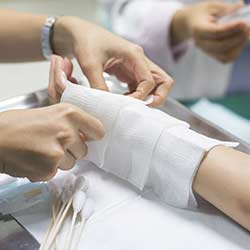
Burn Awareness Week
- February 5
- EVANS / DESHAZO / REILLEY
- Personal Injury
According to the American Burn Association, in 2015, 486,000 people received medical treatment for burns. Each year, about 40,000 people with burn injuries require hospitalization, with 30,000 people requiring treatment in specialty burn centers. Health and safety officials hope to reduce the number of burn injuries in the United States, and that’s why each February the first week of the month marks Burn Awareness Week.
Fire is the most obvious cause of burns, but many serious burns occur at home due to other causes.
Scalding Substances
A person who comes into contact with boiling water, hot cooking grease, or steam may suffer a scald burn. These injuries most often occur at home and are a serious threat to small children.
Liquid and steam burns accounted for about 34 percent of all patient admissions to burn treatment centers in 2013. Many of those patients were children injured in a household accident.
If children can reach a pot of boiling water on a stovetop, or a cup of steaming coffee on a table, they may spill the liquid onto themselves. And because they have delicate, developing skin, burn injuries may cause more severe damage in children than in adults. Elderly people also have delicate skin that can make them more susceptible to burn damage.
Home water heaters also cause many scald burns every year, because the thermostat is either set too high or the heater doesn’t have a thermostat that can be adjusted. The Consumer Product Safety Commission recommends manufacturers ensure water heaters can reach a temperature no higher than 120 degrees, but compliance with that recommendation is not required. And water heaters sold before the CPSC made those recommendations may be capable of reaching much higher temperatures.
About 1,500 hospital admissions and 100 deaths occur each year because of excessively high home water temperatures. Again, children and the elderly are at greater risk for this type of injury, due to their fragile skin. Also at risk are people who lack sensitivity in their extremities or have impaired reaction time – both factors that may interfere with one’s ability to detect dangerously hot water until it’s too late.
Other Household Burns
A number of items typically found in a home’s utility closet, or under the kitchen sink, are extremely corrosive to skin. Chemical burns may occur if a person’s skin comes into contact with oven cleaner, ammonia, batteries leaking acid, and drain cleaners containing lye or sulfuric acid.
Fireplaces also pose a burn risk. Burns to the hand may occur when someone attempts to pick up an iron fireplace tool that’s been sitting close to the flames or attempts to readjust a protective metal grate. Homeowners may think that a glass fireplace enclosure will help protect children from burns, but that glass can reach 200 degrees within six minutes – if a child places her hands on the glass, she could suffer instant burns that result in long-term impairment.
Children should not be allowed access to clothes irons, curling irons, grills, or any metal or glass that reaches high temperatures. Children don’t have the same understanding of risk as adults do, and many serious burn injuries occur every year because a curious child got hold of something dangerous in the home.
Families with small children or elderly relatives may want to discuss how they can protect their loved ones from burn hazards. The Burn Foundation, SafeKids.org, and other health and safety organizations offer plenty of tips and resources about how to keep family members safe.

 Serving Clients Throughout Texas
Serving Clients Throughout Texas
 Chip Evans is a partner at Evans & Herlihy. Chip brings to the firm more than 20 years of experience as a trial lawyer representing Plaintiffs. It is the desire to help individuals, not corporations, that attracts Chip to this side of the docket. [
Chip Evans is a partner at Evans & Herlihy. Chip brings to the firm more than 20 years of experience as a trial lawyer representing Plaintiffs. It is the desire to help individuals, not corporations, that attracts Chip to this side of the docket. [